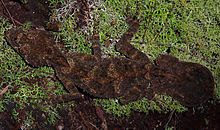
Uroplatus is a genus of geckos, commonly referred to as leaf-tail geckos or flat-tailed geckos, which are endemic to Madagascar and its coastal islands, such as Nosy Be. They are nocturnal, insectivorous lizards found exclusively in primary and secondary forest.

Carphodactylus is a monotypic genus of geckos in the family Carphodactylidae. The genus consists of the sole species Carphodactylus laevis, commonly known as the chameleon gecko. The species is endemic to the rainforests of northeastern Australia. It is rated as Least Concern, as it is common within its range and occurs within protected areas. It currently experiences no major threats, though long-term climate change may alter or reduce its geographic distribution under some scenarios.

Phyllurus is a small genus of Australian leaf-tailed geckos, lizards in the family Carphodactylidae. Rarely seen outside their native habitat, they are notable for their highly effective camouflage which is in part aided by the spiny tubercles that cover every body part.
Lygisaurus is a genus of skinks, lizards in the family Scincidae.
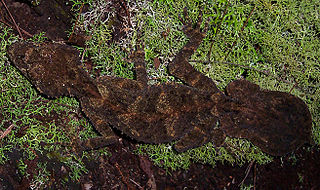
Saltuarius swaini, also known as the southern leaf-tailed gecko or Border Ranges leaf-tailed gecko is endemic to Australia where it is found in coastal mountain ranges of southeastern Queensland and northern New South Wales. It inhabits rainforests and lives inside large tree root systems and hollows of strangler figs. Its scientific name is after Malcolm Swain of the NSW National Parks & Wildlife Service.

Cape Melville is a headland on the eastern coast of the Cape York Peninsula in Australia. To its west lies Princess Charlotte Bay. It is part of the Cape Melville National Park. Cape Melville was named Stoney Cape in 1815 by Lieutenant Charles Jeffreys on the HM Kangaroo but later renamed by him as Cape Melville
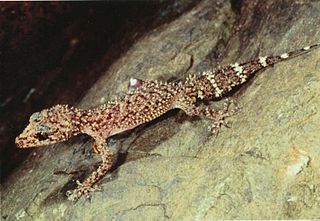
Champion's leaf-tailed gecko, also known commonly as the Koumala leaf-tailed gecko, is a species of gecko, a lizard in the family Carphodactylidae. The species is endemic to Australia.
Leaf-tailed gecko may refer any of the below:
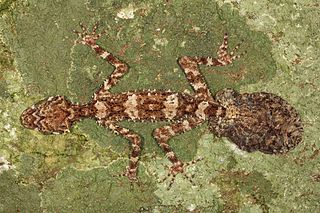
The Cape Melville leaf-tailed gecko is a species of geckos that is endemic to the Melville Range on Cape Melville in Northern Australia. The species was described in 2013 by Australian zoologists Conrad Hoskin and Patrick J. Couper. The lizards are about 20 cm (7.9 in) long and are believed to be a relic species from the time period rainforests were more abundant in Australia. The name derives from the Latin word for "extraordinary" or "exquisite", and refers to the lizard's distinctive, camouflaged appearance. It hides among rocky boulders in the day and emerges at night to hunt on rocks and trees. The lizard has large eyes, a long and slender body, and specialized limbs adapted to life in dimly lit boulder fields.

The northern leaf-tailed gecko is a species of the genus Saltuarius, the Australian leaf-tailed geckos.

Jeanette Adelaide Covacevich (1945–2015) was a herpetologist in Queensland, Australia. As a senior curator of vertebrates at the Queensland Museum, she discovered and studied many reptiles and frogs in Queensland. Covacevich is most famous for rediscovering and describing the Inland Taipan snake, the world's most venomous snake. In addition, she described over thirty new species and genera including the Cape York striped blind snake, the Nangur spiny skink, and the Bulburin leaf-tailed gecko.
Orraya is a monotypic genus of lizard in the family Carphodactylidae. The genus contains the sole species Orraya occultus, also known commonly as the McIlwraith leaf-tailed gecko or the long-necked northern leaf-tailed gecko. The species is endemic to Australia.
Phyllurus amnicola, also known as the Mount Elliot leaf-tailed gecko or the Riverine leaf-tailed gecko, is a species of gecko found in Australia. It is endemic to Mount Elliot in Bowling Green Bay National Park in northeastern Queensland.
Patrick J. Couper is a herpetologist in Queensland, Australia. Born in New Zealand, he migrated to Australia in 1981. Couper began his career at the Queensland Museum in 1984. He was initially employed in display construction, and became a research assistant in herpetology in 1986 under the direction and mentorship of the admired senior curator and head of Vertebrate Zoology, Jeanette Covacevich. Since 1993 he has been Curator of Reptiles and Amphibians at the Queensland Museum. A major research focus has been leaf-tailed geckos that inhabit rainforest and rock habitats in eastern Queensland and New South Wales.
Phyllurus isis, also known commonly as the Mount Blackwood leaf-tailed gecko and the Mount Jukes broad-tailed gecko, is a species of gecko, a lizard in the family Carphodactylidae. The species is endemic to Mount Blackwood and Mount Jukes in mideastern Queensland, Australia.

Phyllurus nepthys, also known commonly as the Eungella leaf-tailed gecko, is a species of lizard in the family Carphodactylidae. The species is endemic to Australia.
Saltuarius kateae, also known commonly as Kate's leaf-tailed gecko or the Mount Marsh leaf-tailed gecko is a species of gecko, a lizard in the family Carphodactylidae. The species is native to New South Wales.
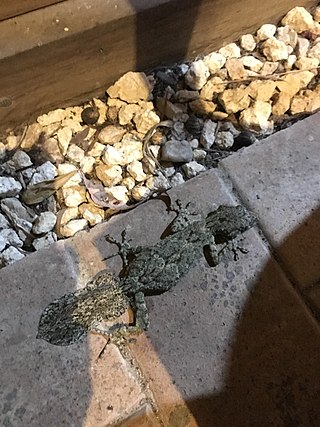
Saltuarius moritzi, also known commonly as the New England leaf-tailed gecko or Moritz's leaf-tailed gecko, is a species of lizard in the family Carphodactylidae. The species is native to Australia.

Saltuarius salebrosus, also known as the rough-throated leaf-tailed gecko or Central Queensland leaf-tailed gecko, is a gecko found in Australia. It is endemic to dry areas in mid-eastern and south-central Queensland.

Pygopodoidea is a gecko superfamily and the only taxon in the gekkotan subclade Pygopodomorpha. The clade includes three Australasian families: Diplodactylidae, Carphodactylidae, and Pygopodidae. Traditional gekkotan systematics had considered Diplodactylidae and Carphodactylidae as subfamilies of the family Gekkonidae, but recent molecular work have placed Pygopodidae within Gekkonidae making it paraphyletic. These analyses have shown support of Pygopodidae and Carphodactylidae being sister taxa, with Diplodactylidae occupying a basal position in Pygopodoidea.
